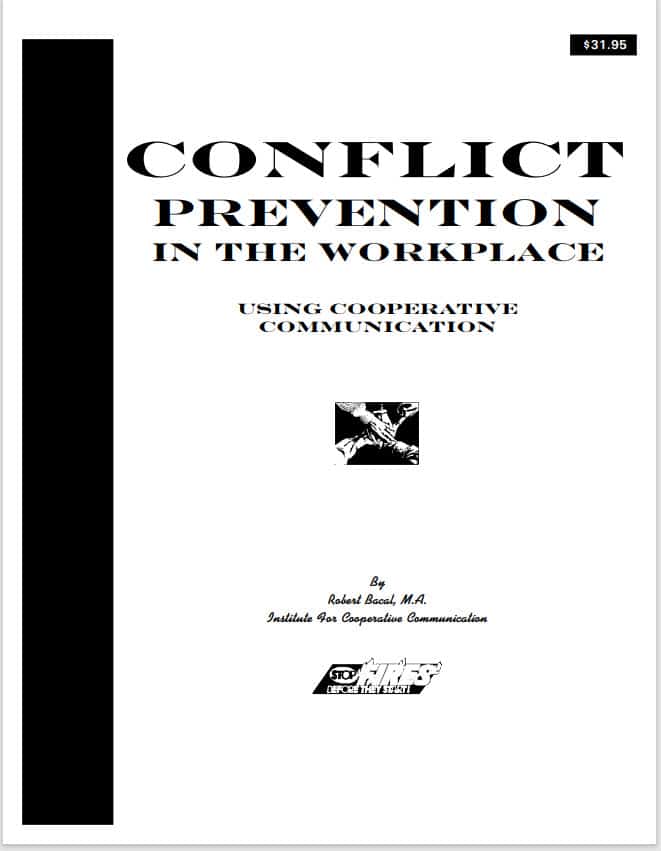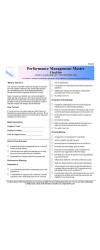Original price was: $21.00.$14.95Current price is: $14.95.
The words you use (and a few other things) determine if your communication will be well received, or whether it will evoke anger and disagreement. Much conflict can be prevented by the use of cooperative communication, a method of peaceful communication.
Description
Conflict Prevention In The Workplace – Using Cooperative Communication
Just like cholesterol there’s good conflict and bad conflict. If you can prevent the bad, unnecessary conflict, you can save huge amounts of time, and pain associated with the “bad” stuff!?
Good conflict is about issues. Bad needless conflict is more emotional, time consuming and difficult.
Conflict about issues goes like this. You want to go bowling. I want to go to a movie. We have an issue, and a decision to be made. We can work that out. No real problem here.
Bad conflict is about clashes of style and communication. It goes like this. You want to go bowling. I say “Why do we always have to do what YOU want?”
What I’ve done is created a completely different conflict that isn’t about where we go, and I’ve probably offended you. We are no longer dealing with the same issue. Now we’re dealing with hurt feelings. And that’s trouble!
I’ve created a completely unnecessary conflict because I’ve used confrontational language. What if I said this instead: “How about if we go to a movie tonight, and then tomorrow we’ll go bowling” Now we’re back to dealing with the good, easy conflict, because I used cooperative language, which, incidentally, pushes us to a solution, rather than emotional banging at each other.
So, what’s our point here?
In the workplace there’s surely enough issue based conflict to keep us all quite busy. We don’t need more. We don’t need more unnecessary conflict that could be prevented by the simple use of proper positive language.
No, it’s not about bowling. It’s often about working with each other and dealing with who does what, when, priorities and all of the other elements of working together.
Here’s the key. Deal with issue oriented conflict as it occurs. Good people can figure that out provided they don’t poison the relationships with bad conflict using confrontational language. And work to eliminate the bad conflict.
Get Less Conflict by Altering How You Communicate – Conflict Prevention In The Workplace – The Book
This quick read book (about 100 pages), explains the difference between cooperative and confrontational communication, and tells you how to change your language to avoid these unnecessary “personality conflicts”. People can take these specific conflict prevention techniques and use them IMMEDIATELY. You can do it and you’ll be amazed at how quickly you can eliminate unnecessary, wasteful, destructive, and time consuming conflict.
Origins
After having worked with thousands of people helping them deal with difficult and angry solutions, I (Robert Bacal) turned to the issue of prevention. I noticed that people who are involved in little conflict actually communicate differently than those who seem to be involved in a lot of conflict situations, and that these differences occur at work and in personal relationships. In short, there are people who are almost completely conflict free AND, they are not avoiding conflict or ignoring it. They stop escalation, and prevent conflict.
This book teaches you how small modifications in how you communicate will affect the degree to which you actually contribute to conflict situations. If you change your communication ability, you can significantly reduce conflict around you.
The Author: Robert Bacal has spent the last 10 years teaching people how to defuse conflict. With this innovative book, he turns his attention to getting at some of the roots of conflict. He is also the author of The Complete Idiot’s Guide To Dealing With Difficult Employees, available at your local bookstore (sorry, now out of print).
Book Features: While this book has its roots in psychology and psycholinguistics, it is written in a style anyone can understand, with lots of examples. It explains what you need to stop saying, and how to replace conflict provoking language. It is also short. You needn’t spend days wading through complex explanations. This book is about 100 tightly written, lean pages.
Table of Contents
Conflict In Organizations – An Overview
- The Inevitability of Conflict
- Good Organizational Conflict
- Ugly Conflict
- Contributors to Ugly Conflict In The Workplace
- Summary
- Key Points
Cooperative VS Conflict Provoking Communication
- Cooperative Vs. Conflict-Provoking Communication
- The Essential Difference: Cooperative Communication
- The Psychology Beneath Cooperation & Confrontation
- What Angers People Or Primes The Conflict Pump
- Lack of Listening/Understanding
- “Less Than” Communication
- Communicating Mistrust
- Violations of Conversation Rules
- Blatant Generalizations
- Power/Status-Based Communication
- Other Sources
A Brief Conflict-Provoking Communication Self-Assessment
Specific Conflict-Provoking Behaviors
- Person Centered Comments & Criticism
- Past Centered Comments
- Guilt-Induction Attempts
- Blaming Comments
- Inappropriate Reassurance and Positive Thinking
- Unsolicited Advice/Commands
- Lengthy Attempts At Persuasion
- Defensiveness-Causing Questions
- Extended Attempts To Win
- Mistrust Statements
- Overstatements and Over-generalizations
- Infallibility Comments (and qualification comments)
- Histrionic Behavior (Over dramatization)
- Use Of Hot Phrases and Words
- Words or phrases that suggest disinterest
- Phrases that blame or imply blame or suggest ignorance
- Absolute words
- Phrases that suggest helplessness (brush-offs)
- Phrases that have a threatening undertone
- Phrases that challenge or dare
- Use of Code Words and Innuendo
- Passive-Aggressive Behavior
Replacing Conflict Provoking Communication With Cooperative
In this chapter we teach you what to say INSTEAD of the “fightin words” so you can focus on solving the issue and not on hurting feelings or emotionalizing the disagreement (if any) Specific phrases you can modify or use as is.
Communication General Cooperative Communication Strategies
- Active Or Reflective Listening
- Empathy Responses
- Assertive Behavior
- Responsiveness
- Steps In The Responsiveness Process
- The Responsive Team Member’s Creed
- Key points: Responsiveness Checklist
Organization, Team, and Management Involvement In Conflict Prevention – Effective Teams
- Establishing Guidelines, Norms, and Processes
- How Do You Make Rules & Guidelines A Reality?
- The Role of Those In Formal Authority
There’s even more. We also include sections on electronic communication, how to handle people who insist on behaving badly and a question and answer section.









